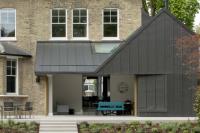 Add My Company
Add My Company
Sign In
How Do Sliding Glass Pocket Doors Work?
06-09-2022

What Are Sliding Pocket Doors & How Do They Work
Pocket doors are an excellent choice of glazing solutions for homes that want to be able to completely merge two spaces.
The design options are endless, with the ability to conceal the head and base frames of the sliding doors within the building finish for a frameless design.
The slim aluminium framing profiles can also be specified with a wide range of finishes, such as polyester powder coating with over 200 RAL colours to choose from, anodised finishes and other special finishes.
A variety of technical glazing solutions can also be incorporated into the sliding pocket doors including solar control glass and electrical glazing solutions such as heated glass.
But firstly, what are sliding glass pocket doors and how do sliding glass pocket doors work?
What Is a Sliding Glass Pocket Door?
A sliding glass pocket door is a sliding glass door that slides into a wall cavity, meaning when open the door is concealed, leaving a completely open aperture.
Pocket door systems are a great alternative to bifold doors on projects that aim to merge the interior and exterior spaces by specifying a glazing system that when open, makes to most of the structural opening.
Not all projects are suited to a sliding glass pocket door as the surrounding wall structure will need to be able to support and open cavity for the door to slide in to.
Our team work closely with the architects on the projects to ensure that the right system is specified and meets all project requirements, both in terms of aesthetic and performance.
Stonecrop, a sustainable new build home located in the East Midlands, was designed with minimal windows® slim sliding doors. Sliding glass pocket doors were utilised in this award-winning home design to allow interior spaces to have a strong connection to the outdoors.
How Do Sliding Glass Pocket Doors Work?
Sliding glass pocket doors work by having a track that continues into a wall cavity. When open the sliding door is concealed within the wall pocket, leaving an open aperture.
Due to the need for a wall cavity, sliding glass pocket doors should be considered early in the project to ensure the building structure is suitable for this.
A stopper is located at the end of the cavity to ensure smooth stopping when the door reaches the end and help prevent any damage to the sliding glass pocket door system.
Sand Dunes, a luxury coastal new build in Mawgan Porth, Cornwall, benefits from multiple minimal windows sliding doors in various configurations. This includes one and two track sliding glass pocket doors on the upper floor, giving the internal spaces ample access to the external balcony areas.
There is no limit to the number of sliding panes that can be concealed within the wall cavity, however, it is important to consider that 60mm is needed for each pane and therefore the building structure and depth of the wall will place a limitation on the number of sliding panes.
A three pane sliding glass pocket door was installed in a contemporary extension in London. The slim aluminium framing was specified with a dark grey finish to match the zinc cladding on the extension.
Our slim sliding pocket door systems can be specified in unique configurations such as a biparting sliding pocket door configuration or in an open corner sliding pocket door configuration.
Depending on the structure of the building, a support post may not be necessary to support the roof above an open corner pocket door. This means that when the doors are open, that section of the room is completely opened and merged with the outdoors.
An excellent example of this is our Malbrook road project, where minimal windows sliding pocket door systems were specified in the modern extension as open corner pocket doors.
As the extension is a single storey extension, no supports were needed, and with the aid of the completely flush threshold of our sliding door, the new living space can be merged with the contemporary patio design.
We recommend the internal finishes be applied by others inside the pocket. This is because when the pocket door is in the open position, the internal pocket finishes will be visible.
If you require a DWG file of the pocket door detail to drop straight into your architectural plans, please contact the team who will be happy to assist.
For more information on sliding glass pocket doors, contact the team today.
For more information on How Do Sliding Glass Pocket Doors Work? talk to Minimal Windows® by Keller
Enquire Now
List your company on FindTheNeedle.

